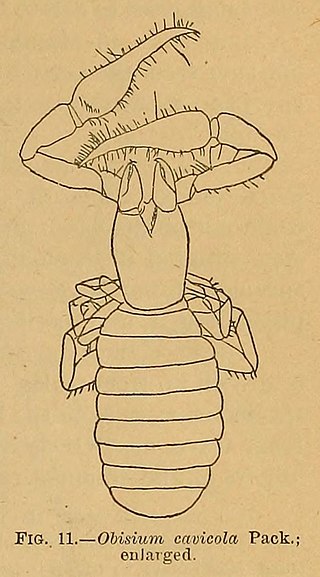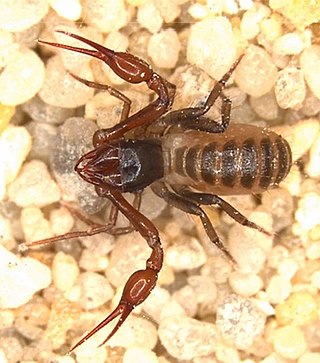
Pseudoscorpions, also known as false scorpions or book scorpions, are small, scorpion-like arachnids belonging to the order Pseudoscorpiones, also known as Pseudoscorpionida or Chelonethida.

Chthoniidae is a family of pseudoscorpions within the superfamily Chthonioidea. The family contains more than 600 species in about 30 genera. Fossil species are known from Baltic, Dominican, and Burmese amber. Chthoniidae now includes the former families Tridenchthoniidae, and Lechytiidae which has been demoted to subfamilies.

Neobisiidae is a family of pseudoscorpions distributed throughout Africa, the Americas and Eurasia and consist of 748 species in 34 genera. Some species live in caves while some are surface-dwelling.

Chitrella is a genus of pseudoscorpions in the family of Syarinidae.
Austrochthonius is a genus of pseudoscorpions in the family Chthoniidae. It was described in 1929 by American arachnologist Joseph Conrad Chamberlin.
Austrochthonius easti is a species of pseudoscorpion in the Chthoniidae family. It is endemic to Australia. It was described in 1991 by Australian arachnologist Mark Harvey. The specific epithet easti honours Malcolm East, who collected one of the specimens.
Austrochthonius strigosus is a species of pseudoscorpion in the Chthoniidae family. It is endemic to Australia. It was described in 2006 by Australian arachnologists Mark Harvey and Lee Mould. The specific epithet strigosus refers to the slender pedipalpal chela.
Lagynochthonius mordor is a species of pseudoscorpion in the Chthoniidae family. It is endemic to Australia. It was described in 1989 by Australian arachnologist Mark Harvey. The specific epithet mordor refers to the type locality.
Tyrannochthonius cavicola is a species of pseudoscorpion in the Chthoniidae family. It is endemic to Australia. It was described in 1967 by Austrian arachnologist Max Beier.
Tyrannochthonius cavernicola is a species of pseudoscorpion in the Chthoniidae family. It is endemic to Australia. It was described in 1976 by Austrian arachnologist Max Beier.
Pseudotyrannochthonius hamiltonsmithi is a species of pseudoscorpion in the Pseudotyrannochthoniidae family. It is endemic to Australia. It was described in 1968 by Austrian arachnologist Max Beier.
Pseudotyrannochthonius gigas is a species of pseudoscorpion in the Pseudotyrannochthoniidae family. It is endemic to Australia. It was described in 1969 by Austrian arachnologist Max Beier.

Pseudotyrannochthonius giganteus is a species of pseudoscorpion in the Pseudotyrannochthoniidae family. It is endemic to Australia. It was described in 1971 by Austrian arachnologist Max Beier.
Anatemnus cavernicola is a species of pseudoscorpion in the Atemnidae family. It is endemic to Australia. It was described in 1976 by Austrian arachnologist Max Beier. The specific epithet cavernicola ('cave-dwelling') refers to the species’ habitat.
Austrochernes guanophilus is a species of pseudoscorpion in the Chernetidae family. It is endemic to Australia. It was described in 1967 by Austrian arachnologist Max Beier.
Austrochernes imitans is a species of pseudoscorpion in the Chernetidae family. It is endemic to Australia. It was described in 1969 by Austrian arachnologist Max Beier.
Protochelifer cavernarum is a species of pseudoscorpion in the Cheliferidae family. It is endemic to Australia. It was described in 1967 by Austrian arachnologist Max Beier.
Protochelifer naracoortensis is a species of pseudoscorpion in the Cheliferidae family. It is endemic to Australia. It was described in 1968 by Austrian arachnologist Max Beier. The specific epithet naracoortensis refers to the type locality.
Cryptocheiridium australicum is a species of pseudoscorpion in the Cheiridiidae family. It was described in 1969 by Austrian arachnologist Max Beier.




